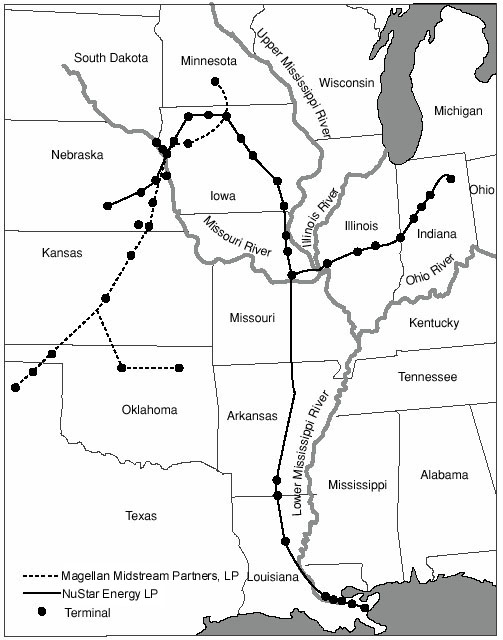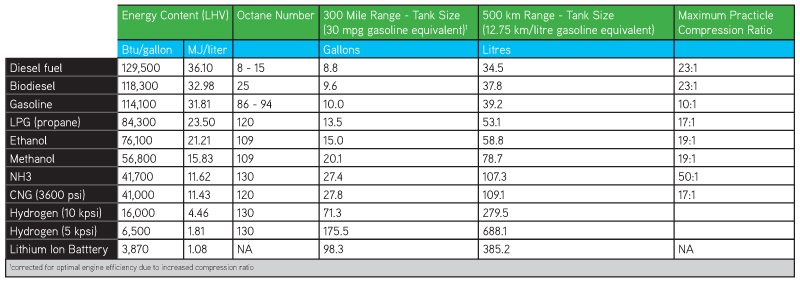The Logical Path Forward
There are numerous choices being proposed as viable alternative fuels. Some of the leading candidates include biofuels (e.g., ethanol, butanol, methanol, bio-diesel, renewable diesel), natural gas, hydrogen, propane and dimethyl ether (DME). Each of these choices have associated benefits and liabilities.
The optimal path for determining which alternative fuel (or fuels) would best serve the needs of the U.S. should begin with a thorough, logical identification of the characteristics of an “ideal” fuel. The critical task then becomes evaluating each alternative fuel choice relative to the following ideal fuel criteria.
The characteristics of an ideal fuel include:
• Produced from any primary energy source (e.g., wind, solar, biomass, coal, nuclear, hydro, ocean thermal etc.)
• Cost effective vs. gasoline, natural gas, batteries, biofuels, hydrogen, etc.
• Significant storage and delivery systems already in place
• Environmentally friendly (no carbon, low emissions)
• Practical application (i.e. diesel engines, fuel cells, SI engines, gas turbines, etc.)
• Proven, acceptable safety history
• Sustainable
• Produced in the U.S.
NH3 Fuel: The Closest Alternative to an Ideal Fuel
A thorough evaluation of each potential alternative fuel against the ideal fuel criteria listed, leads to the choice of NH3 (anhydrous ammonia) as the leading alternative fuel candidate. NH3 has been called “the other hydrogen” and exhibits all of the advantages of hydrogen. Importantly, NH3 provides proven, practical, low-cost storage and delivery of hydrogen, the main barrier to a hydrogen economy.
Alternative Fuels Information
NH3 performance and benefits:
Production Flexibility NH3 can be produced from any primary energy source (e.g., wind, solar, biomass, coal, nuclear, hydro, ocean thermal etc.) Hydrogen is the only other fuel that can make this claim.
Cost effective NH3 has historically been priced competitively with gasoline and petroleum on an energy content (i.e., $/MM BTU basis). NH3 is currently produced from natural gas and coal. Current (April 2010) U.S. prices for coal, natural gas, and gasoline are $1.20, $3.97, and $20.00 per million BTU respectively. Since NH3 is currently made from coal and natural gas, both of which are substantially lower in cost than gasoline, NH3 will generally be cost competitive with gasoline as long as the historical relative cost difference between coal, natural gas and gasoline remain.
 Infrastructure Significant, world-wide storage and delivery systems are already in place for NH3 used in fertilizer applications. It is in the top three chemicals transported annually. NH3 has been transported by ship, barge, rail car, truck, and pipeline for decades. Large (20,000 to 30,000 ton), low-cost NH3 storage tanks are currently installed in many areas of the US. There are over 800 retail NH3 distribution facilities in Iowa alone.
Infrastructure Significant, world-wide storage and delivery systems are already in place for NH3 used in fertilizer applications. It is in the top three chemicals transported annually. NH3 has been transported by ship, barge, rail car, truck, and pipeline for decades. Large (20,000 to 30,000 ton), low-cost NH3 storage tanks are currently installed in many areas of the US. There are over 800 retail NH3 distribution facilities in Iowa alone.
Environmental Performance NH3 Fuel is environmentally friendly, producing zero carbon dioxide and low overall emissions. The only significant pollutant emitted by either hydrogen or NH3 is NOx. Gasoline and Diesel exhaust also contains NOx, and NH3 is commonly used to reduce these emissions. With an on-board supply of NH3 Fuel it will be even easier and more cost effective to use NH3 to react with NOx over a low-cost catalyst and produce environmentally benign N2 and H2O.
Fuel Flexibility The ability to be used in any prime mover (e.g., diesel engines, fuel cells, SI engines, gas turbines, etc.) is a tremendous advantage associated with NH3 Fuel.
Availability The United States has 15 to 20 million tons of liquid NH3 in distribution networks on an annual basis. Until now, that NH3 was primarily used as a fertilizer and commercial refrigerant. Many states, such as Iowa, have an extensive “filling station” network, which the same low pressure equipment could be used to supply NH3 fuel to farm machinery and ultimately highway vehicles. Such an NH3 fuel delivery network would be fairly straightforward to implement compared with, say, hydrogen.
Safety NH3 has an extensive, proven record of acceptably safe use. In addition, two very credible studies have shown that NH3 would be safer than propane and as safe as gasoline when used as a transportation fuel. There are many misconceptions surrounding the safety of NH3 and providing credible, factual data on this topic is very important and a key goal of the NH3 Fuel Association.
Some facts regarding the safety of NH3:
- NH3 is a weak base and is easily neutralized with weak acids such as citric and acetic acids
- NH3 has a much better safety record (e.g. loss of lives) compared to gasoline, propane and natural gas
- Zero carbon, no resultant Greenhouse Gases (GHG) on combustion
- NOx is easily neutralized (NH3 is used as the active chemical reactant in NOx reduction, and CO2 and SO2 capture)
- If released in an accident, NH3 is very difficult to ignite, is lighter than air (dissipates upwards), and its odor alerts
- NH3 is not a Greenhouse Gas (GHG)
- Will not damage the ozone layer
Sustainable NH3 can be produced from wind, solar, or any other renewable fuel using existing production methods, and new technology, currently in development, hold promise to significantly reduce sustainable production costs.


